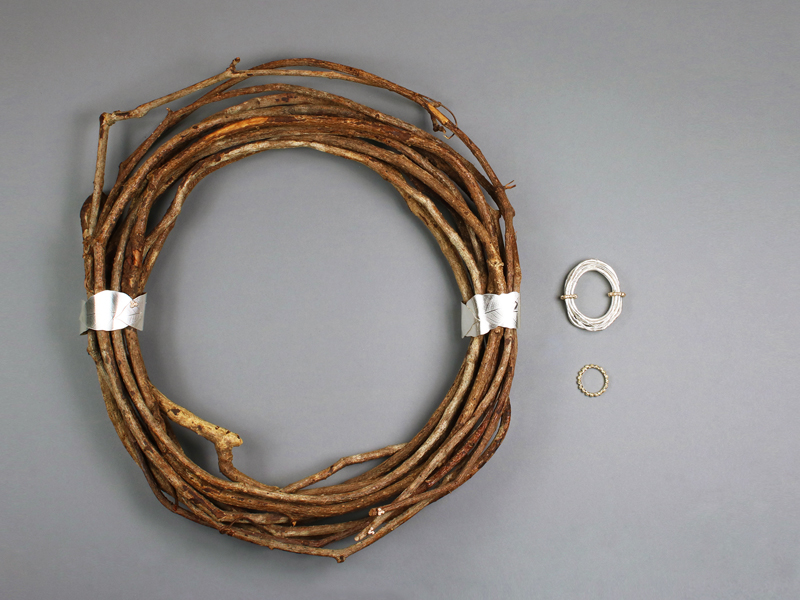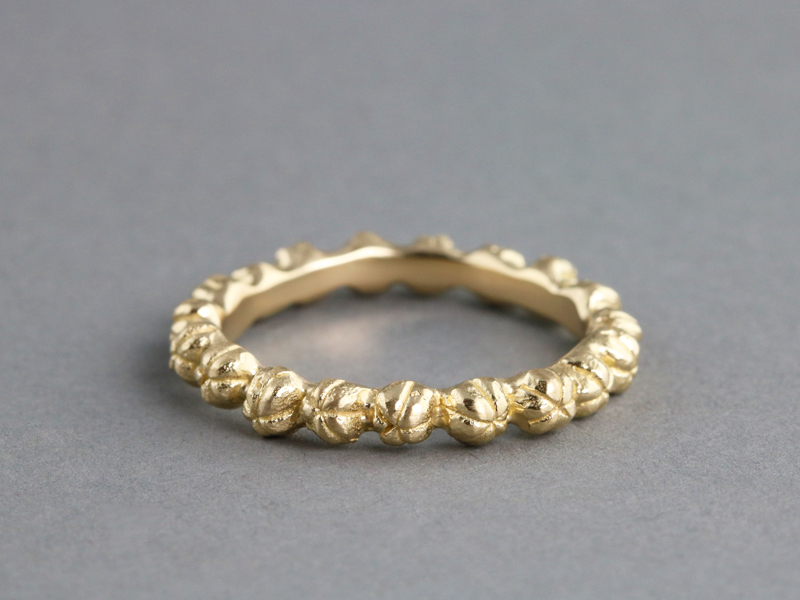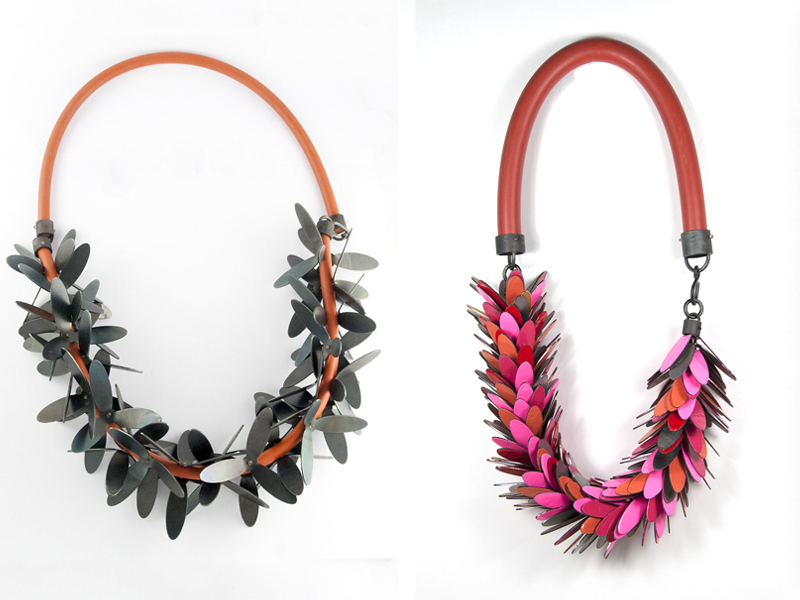
Botanical Illustrations is a group show, curated by Taboo Studio, of five international jewelers—Laura Baxter, Janice Ho, Sarah Hood, Kyunghee Kim, and Maia Leppo—who reinterpret this theme from the perspective of their own individual aesthetics. One of the artists, Seattle-based Sarah Hood, discusses her approach.
Sandra Wilson: What is your underpinning philosophy of nature? Are you a city girl, or were you brought up in the countryside? Or put another way—where did your reverence for botanical forms come from?
Sarah Hood: I am a city girl who has moved around a lot—I lived in Seattle; Detroit; Honolulu; Columbus, Ohio; and New York City all before the age of nine, and Boston; Santa Cruz, California; NYC; and Seattle again as a young woman.
In addition, I grew up in a family that valued travel, and we traveled regularly both domestically and internationally. A love of seeing the world is something I’ve carried into adulthood, and I continue to travel several times a year. What has rooted me in every city I’ve lived in or visited is finding a literal grounding in a place—recognizing the flora that makes a region unique, and connecting with a place based on that. My memories of cities I’ve lived in or visited are often tied up with memories of certain twigs I collected there or trees I saw there that I hadn’t seen before—collecting tall grass on the side of a railroad track in the middle of Canada or marveling at the live oak trees dripping with moss in Savannah, Georgia. My work has celebrated the ordinary beauty of the natural forms I’ve collected over the years, and the pieces I’ve created are almost always wound up with the memory of a place I’ve been. I like the idea that varying landscapes can tie us to specific places and cause us to consider how we fit into the world in general.
Is it the forms and textures in nature that you are attracted to? Or would you also consider nature to be a system that informs your approach to making? Which botanicals are you attracted to—those that you are familiar with locally, or is it the more exotic and unusual forms that interest you?
Sarah Hood: I consider the forms and textures of nature inherently perfect, something I don’t need to mess with too much. Nature has it pretty much figured out, and there’s not much more I can add. In many of my pieces I work to highlight this natural beauty without distortion. I’m attracted to natural forms of all kinds, from the exotic to the mundane. I’ve worked with sticks I’ve found on the side of the road, whole spices from my kitchen cabinet, and precious flora collected on trips around the country.
There is a long history of reverence for nature within jewelry, for example within Art Nouveau. What is contemporary about your approach?
Sarah Hood: What I try to do in each piece is highlight the natural form I’m using in whatever way seems right for the piece as a whole. I like to create composed pieces that feel uncomplicated but structured, and that sometimes lean more toward sculpture than jewelry. I am not always concerned with wearability, though I consider some of my most successful pieces those that have a sculptural feel but still work on a body.
Whatever spurred Lalique and his contemporaries to find their inspiration in the natural world, they, too, soon translated organic forms into fabricated objects—thus turning the “natural” into something artificial. Isn’t that a little self-defeating?
Sarah Hood: I don’t view making the impermanent permanent as self-defeating. I see it as the opposite—it is self-preserving. When we draw on and work with forms and materials that would basically self-destruct through natural decay over time, the only way to preserve these forms is by rendering them in a permanent material. Metal is a perfect medium for this as it can pick up and hold endless textures and subtleties and has the structural integrity to hold onto them forever.
How important is drawing and observation from direct experience to you?
Sarah Hood: I sketch some pieces out before making them, but not always. Sometimes I work directly, composing a piece on my workbench and adding to it or subtracting from it as I work with it over the course of several days or weeks. Observation from direct experience is very important to me and is reflected in the fact that many of the natural forms I work with are those that I have collected myself after studying their forms and growth in the wild.

This show is about your aesthetics—an aspect that is not much discussed these days. Why should aesthetics still matter?
Sarah Hood: Aesthetics are what make us individual. What I find beautiful—you may not. What you respond to—I may not. If a piece of jewelry provokes a sense of beauty, it elicits an emotional response. The only way I can make work that touches someone else emotionally is if I feel touched in some way when I’m creating it. If I make a piece that provokes a strong reaction in me, I can hope that it will have the same effect on someone else. I consider a piece successful if, when I finish it, I am convinced it is the most beautiful thing I’ve ever made.
Most of the work in this show is immensely wearable, and on the scale of the human body. Is wearability important to you?
Sarah Hood: Wearability is not always important to me at all, and isn’t in a couple of pieces in this show. In two of the pieces—Wreath Necklace and Twig Bracelet—I was interested in showing off how engaging wood in its ordinary state can be without adornment and when taken out of its natural setting. In these two pieces the only metal is the silver that binds the branches into their jewelry forms, but the silver is almost an afterthought when looking at the composition of each piece as a whole.
For the rest of the pieces I was interested in creating works that were extremely wearable and that referenced the larger, less wearable works. While it’s not important to me that every piece I make be worn, it’s important to me that many of the pieces I make are worn. While I love making larger, sculptural works, I also want to make jewelry that is jewelry. So for this show I was able to do both.
You are working with metals, mainly precious but including steel. Is there something particular about interpreting botanical sources through metal that is important to you?
Sarah Hood: I have worked with real, natural materials a lot, and find them endlessly interesting and inspiring to work with. When I translate the real, natural materials into metal, I’m looking for a permanence I can’t get from the real botanical forms, a freezing of time at a certain stage in a plant’s life. So, for instance, I can cast a budding branch. In nature this branch will only be at that stage for a few days, but if I mold it and cast it, I can capture that stage permanently. This ability to permanently render a certain stage in the life of a botanical form allows me to work the element into a narrative within a piece of jewelry. Fragile buds, roots, leaves, and flowers that don’t make very sturdy components in wearable jewelry become malleable and durable elements that stand the test of time.

Most of the work appears to rely mainly on traditional hand techniques. Is this because these are also human-centered and have a natural rhythm? Have you adopted new and emerging technologies?
Sarah Hood: I use hand techniques in my work because that’s what I know how to do. When I was going through art school, computer rendering and 3D printing hadn’t made it into my program yet. Maybe some day I’ll learn it, but maybe not. I like hand work because it gives me an immediacy that’s important to me when I’m working.
Where would you locate your practice on the craft/design/art spectrum?
Sarah Hood: I consider myself a craftswoman, a designer, and an artist. I don’t think those practices are on a spectrum. I think they are all parts of a whole that most of us embody as makers.
What would you say are the benefits and disadvantages of being part of a group show?
Sarah Hood: Because a group show allows works from different artists to be shown together, it naturally and often by design invites a dialogue between the works that probably would not occur any other way. Being part of a thoughtfully curated group show may also open your eyes to connections between other artists and works that you may not have seen before. That’s the job of a good curator. Group shows also allow artists to be seen by an audience they might not have reached otherwise.
The disadvantage is that if the work between artists in a group show differs too much, or a connection between artists cannot be found by an audience, the theme of a show is lost.

What other botanical-inspired jewelry artists internationally would you say are producing exciting work?
Sarah Hood: I love the jewelry made from driftwood and other found wood by Dawn Wain, Kiff Slemmons, and Linda Van Niekerk for its simplicity of form and letting the material speak for itself.
I love the representational botanical work of Jan Yager and Marian Hosking, and the more stylized work of Claude Schmitz, Seulgi Kwon, and Kayo Saito.
Thank you!
The works in this show range in price from US$330 to $1190.


INDEX IMAGE: Work in progress on Kyunghee Kim’s workbench, photo: Myungwook Hu, Studio Munch




